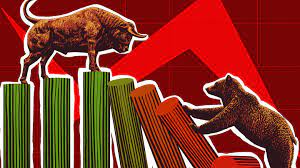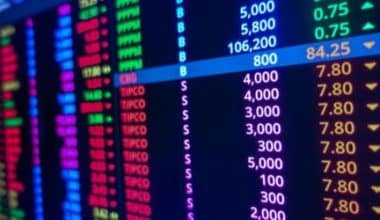Many investors get a tangible feeling of fear whenever they hear the term “bear market.” But severe market drops can’t be avoided, and they usually only last a short time compared to bull markets, when the market’s value goes up. Even during a bear market, there may be opportunities to make profitable investments in crypto or stocks. Keep reading to learn more about what a bear market is, what to do in a bear market, the difference between a bear market and an intermediate market correction, and how to make sure your portfolio survives (and even does well) until the bear turns into a bullish market.
What Is a Bear Market?
A “bear market” is a time when the value of assets goes down. This usually happens when a broad market index drops by 20% or more from its most recent high. A bullish market is the opposite of a bear market, and it’s defined by gains of 20% or more.
Furthermore, the threshold is a 20% drop, but a drop in prices typically falls much more than that over time. Relief rallies are short periods of relative stability that happen very rarely in a drop in price, but overall, the market is still moving in a bad direction. Bear markets occur when investors lose faith in the market. While prices are falling rapidly in a bear market, investors typically tend to disregard any good news and keep selling. The drop in price ends when investors decide the equities are a good deal and start buying them.
Bear markets can affect the entire market (as seen in the Dow Jones Industrial Average) or just one stock. When investors are bearish about a certain stock, the market as a whole is not likely to react badly. Even with excellent news and rising earnings, stock values tend to fall when the market or index falls.
Is It Good to Buy in a Bear Market?
Bear markets are scary, but if they last long enough, they can lead to great buying opportunities. Now is the time to invest if you want to buy a lot of high-quality equities for a price that is a fraction of what they would normally cost. On the other hand, buying stocks is only step one; the real challenge lies in protecting such investments against a down market. This is the more challenging aspect of investing.
What Are the Characteristics of a Bear Market?
In the financial sector, there are always times when things are going up and times when things are going down. The following characteristics indicate the start of a drop in price:
- Stock market drops: When broad market indexes continue to fall by 20% or more over an extended period of time, we are experiencing a bear market.
- Economic downturn: When stock markets are experiencing a bear market, the economy as a whole tends to be in a state of decline. This is characterized by increased unemployment, a fall in the gross domestic product (GDP), and a decline in the earnings of corporations.
- Negative sentiment: During a bear market, market sentiment is poor. Due to the pessimism that investors have regarding the future of the stock market, it is more likely that they will sell their assets than keep them. Because of their fears about how the market will perform in the future, investors are likely to place their money into more secure investments such as bonds.
- A drop in price lasts much longer than typical drops in the stock and crypto markets. At least a two-month-long downward trend is required for there to be considered a bear market. The average duration of a drop in price is approximately ten months.
What Are the Causes of a Bear Market?
The following are some of the major reasons for a bear market:
- Recessions
- Market bubbles bursting (Tech bubble, U.S. subprime housing crisis)
- Policies in either the monetary or the fiscal sphere that are excessively contractionary
- Crises in the public health system (such as the SARS and COVID-19
- Sluggish growth of the economy and weak economic data
- Geopolitical crises (such as the Persian Gulf War and the War in Ukraine)
The duration of a bear market is a crucial factor in determining whether it is secular or cyclical. A secular drop in price is one that has been going on for an extended period of time, typically years, and is driven by forces and influences that lead the price of assets to fall.
On the other hand, a cyclical bear market is typically brought on by the natural volatility of the market, and its duration is typically measured in months.
How Long Does the Bear Market Last?
Bear markets can be very bad for a country’s wealth, but they usually only last for a shockingly short time. In point of fact, the typical duration of a bear market is only 9.6 months. Therefore, the bear market should be over in fewer than twelve months in the vast majority of cases.
What to Do in a Bear Market
Bear markets can be scary for investors, and no one likes to see the value of their holdings go down. However, when equities are trading at a discount, it can be a good time to make a long-term investment.
Here are things to do in a bear market:
#1. Refrain from Taking Any Action
Many investors often shoot themselves in the foot because they don’t have enough discipline or good investing habits. To summarize, investors tend to “buy the exhilaration” of a bullish trend and “sell the gloom” of a bear market. In the world of investing, you can beat the typical investor by doing nothing. Do not check your investment accounts. Avoid seeing the stock market reports. You should avoid reading the newspaper. Close your investment account statements.
If you do nothing else during a drop in price, make it a point to do as little as possible. If you wait until the market has already started falling before selling high and buying low, you may be sorry. Additionally, your opaque crystal ball won’t tell you when to buy, just as it didn’t tell you when to sell. Realize that time spent in the market is more important than trying to time the market. Because you won’t need to withdraw from your retirement account for decades, you should invest accordingly.
#2. Postpone Big Buys, Focus on Investments
Many people who put money into the stock and crypto markets don’t realize that a bear market actually provides some of the best opportunities to profit in the long run. In a bear market, you should be adding to your holdings rather than selling them since you can get a better deal. That’s why it’s a smart move to put off buying a few big-ticket items for a while. Now is not the time to get that new car, boat, kitchen, or exotic vacation you’ve always wanted.
Take advantage of the fact that doctor’s salaries are usually very stable, even during recessions, by contributing to backdoor Roth IRAs, speeding up 401(k) contributions, opening that taxable investment account, and so on. Doctors can invest during a bear market, taking advantage of market lows to increase their long-term gains.
#3. Receipt of Tax Deductions
Government assistance is available to ease the financial impact of losses in taxable and non-qualified accounts. Holding on to declining investments in the hopes of recouping losses is counterintuitive; instead, you should sell them and buy something extremely similar, but not “substantially identical,” as the Internal Revenue Service puts it. You can deduct the loss from your taxes while seeing little change in the performance of your investments.
Tax loss harvesting describes this practice. Your tax losses can offset future capital gains if you deduct up to $4,000 from your ordinary income. Even though this will probably lower your basis and raise your future taxable gains, you will be able to put off paying taxes on those gains for a long time, possibly until you are in a lower capital gains tax band.
Donating appreciated shares to charity or leaving them to heirs at death lets the recipients take advantage of the sharp increase in basis at death without having to pay capital gains tax on the appreciation. This will allow them to sell the investment free of any tax liability for gains accrued during your lifetime.
#4. Consider Your Asset Allocation and Risk Tolerance
You may learn a lot about your risk tolerance in a drop in price, especially if it’s your first one. If you have based your asset allocation or investment strategy on a prediction of your risk tolerance, you may now find out if you have guessed too high, too low, or about right.
If your risk tolerance is higher than your current asset allocation, it may be time to put more money into risky investments. Even if you don’t buy at the bottom, you can get a better value than at the market’s height.
If you can’t sleep because of your losses, like many investors, it’s a sign that you have too many risky assets. However, the moment to switch to a less risky asset allocation is not now. After a year, two, or even three, the bull will inevitably return, and you’ll have made up for all of your previous losses. Just attempt to sell a small bit if you can’t take it any longer. You won’t believe how soon you can fall asleep again. Don’t sell everything you own in a panic, but do sell enough to get by until you can sleep comfortably. Doctors I’ve worked with in the past have been guilty of that very thing. Unlike other doctors their age who have better investment discipline, they are still actively practicing medicine.
Are We in a Bear or Bull Market in 2022?
In 2022, U.S. stocks experienced a bear market, defined as a 20% or greater fall. The Federal Reserve’s drastic policy move at the beginning of last year was a key component that contributed to the current bear market. The 2023 equity market climate will remain volatile.
Bear Market Crypto
Bear markets in crypto are an inevitable component of the market cycle. The bear markets and their trends, characteristics, and possible investment opportunities are looked at in detail.
However, when the market is bullish with no sign of stopping, anyone might look like a financial genius. When they drop, especially if they stay low for a while, things might get complicated. This is known as a “crypto bear market” and is the worst possible thing that can happen to investors in any kind of asset, whether physical or digital. No one knows how long a crypto bear market will last, but it is important to prepare your portfolio for a drop.
Crypto Strategies to Consider While in a Bear Market
Bear markets are very hard to beat unless you have a crystal ball, are incredibly lucky, or know more about how the market works than Warren Buffett. However, there are strategies you can employ to enhance the odds that your investment portfolio will survive another day.
#1. Put Your Money Into Industries That Thrive During Economic Downturns
In a bear market, what kinds of investments do well? Consider the necessities that customers have no choice but to buy, as they are the industries most likely to thrive in a bear market. Consumer staples and utilities tend to fare better in bear markets because people still need them even when inflation is high.
Exchange-traded funds and index funds, which follow a market benchmark, allow you to invest in a wide range of industries with a single purchase. An exchange-traded fund (ETF) focused on consumer staples, for instance, would provide exposure to companies in a sector that often performs well even in economic downturns. Buying a single stock is less diversified than buying an index fund or exchange-traded fund (ETF).
#2. Learn to Use Dollar-Cost Averaging to Your Advantage
To increase your chances of profiting from the bear market, which many investors see as an opportunity, consider adopting a dollar-cost averaging (DCA) strategy. DCA means investing a set amount of money in assets at regular times, no matter what the market is doing. The gist of DCA is that it affords you the ability to accumulate more of a given asset at a given price level. Also, it slowly lowers your cost base, which is the average amount you paid per unit of an asset.
#3. Don’t Freak Out and Assume the Worst About the Group’s Mind
Never let your emotions get in the way of your investment decisions. even more so when the market is unfavorable. When investors get scared, they often sell their stocks too soon, causing them to suffer significant losses. Maintain a high level of skepticism at all times, but bear market conditions—when places like Crypto Twitter are saturated with fear, anxiety, and doubt—are especially relevant (FUD). Don’t be too swept away by the enthusiasm or dismay you may experience. Don’t listen to “some guy on Twitter” who advises you to buy cryptocurrency.
#4. Keep your investments diversified
Increasing your portfolio’s diversification so that it includes a variety of various assets is another important strategy, down market or not, because it allows you to purchase equities at lower prices.
In a bear market, the value of every company in a stock index, such as the S&P 500, typically declines, though not necessarily by the same amount. That’s why spreading your investments out is so important. By spreading your investment capital over a number of different sectors and companies, you can reduce the impact of any single sector’s underperformance on your portfolio’s overall performance.
You’d want to know who’s going to win and who’s going to lose before the game even starts. Due to the connection between a crypto bear market and a downturn in the economy, smart investors often look for assets that continue to make money even when the market changes.
#5. Think Long-Term
All investors’ mettle is put to the test during a bear market. A bear market is never fun, but previous experience suggests that you won’t have to wait too long to recover. And if you’re investing for retirement or another long-term objective, the bullish markets you experience will more than makeup for the bear markets you’ll go through. Short-term goals, defined as those with a time horizon of fewer than five years, should not have their funds invested in the stock market.
One of the best things you can do for your crypto or stock portfolio is to avoid the desire to sell investments in a bear market. Have a financial counselor handle your assets during both bullish and bearish markets if you find it difficult to stay out of the market during the latter.
Bullish vs Bear Market
When compared to a bear market, a bullish market is the exact opposite. A long-term rise in stock prices is called a “bullish market,” and it’s often accompanied by high consumer optimism, low unemployment, and strong economic growth.
The general consensus is that a bullish market begins when prices have increased by at least 20% from their bear market lows; however, this threshold is less rigid than that of a bear market. At the end of a bear market, investors often declare the beginning of the next bull market. Take the S&P 500 as an example; it hit rock bottom in March of 2009, marking the beginning of the bull market that would continue until early 2020.
Specifically, a new bullish market can be called when the benchmark indexes have reached new all-time highs and the price of stocks has risen by 20% from their recent bear market lows.
Some notable differences include:
#1. Adjustments to Gross Domestic Product
The sluggishness that follows a bear market often causes consumers to cut back on their spending, which in turn reduces GDP. Companies see an increase in revenue during a bullish market, and consumers are more willing to spend during times of economic expansion.
#2. Economies of Scale: Supply and Demand
Stock prices rise during a bullish market because of a rise in investor demand for those stocks. During a bear market, the contrary is more common. Investors are trying to get their money back as quickly as possible, which is causing the supply of securities to rise and their prices to fall.
#3. Variations in the Unemployment Rate
During a bullish market, when businesses are expanding and bringing in more money, they may need to recruit more people and may have the financial resources to do so, perhaps resulting in a lower unemployment rate. During a bear market, it is common for businesses to stop hiring new people and even let some people go.
Bear Market vs. Intermediate Market Correction
The difference between a market correction and a bear market is the size of the drop in stock prices. These two developments also occur at separate rates and across distinct time periods. People use the terms “correction” and “bear market” interchangeably. A “correction” is a drop in the market as a whole, while a “bear market” is a drop in certain assets. Here is a brief difference:
| Market Correction | Bear Market | |
| Time to Recover | Shorter recovery period | Longer recovery period |
| Time Frame | Indefinite time | It takes at least two months |
| Percentage decline from recent high | 10% | 20% |
| Frequency | More | Less |
A market correction is defined as a loss in a broad market index (or an individual asset) of at least 10% from its most recent peak but less than 20%. Conversely, a bear market occurs when a broad market index falls by 20% or more from its previous high.
How Much Cash Should You Hold in a Bear Market?
Maintaining a cash reserve for unexpected expenses is important, and you should also consider keeping some money on hand to invest in the stock market when you believe the time is right. A common piece of advice given by financial experts is to set aside six months’ worth of living costs in cash.
Conclusion
When market prices drop by more than 20 percent from their most recent high, it might be unsettling for investors, but the one thing they should avoid doing is panicking. But a bear market usually lasts less than a year, and investors can lessen the impact of these downturns by using simple strategies like dollar-cost averaging, diversification, investing in industries that are less affected by recessions, and keeping an eye on the long term.
Bear Market FAQs
How often do market corrections happen?
Despite just about 26 bear markets since 1929, market corrections occur significantly more frequently, on average once every other year.
What is the longest bear run in the stock market?
The current record for the longest bear market is 929 days, which lasted between 2000 and 2002.
What are the stages of a bear market?
- Recognition
- Panic
- Stabilization
- Anticipation
Similar Posts
- BEAR RIVER CAR INSURANCE: Rates, Coverages, and Reviews (Updated!).
- NOSE SURGERY COST: Comprehensive Cost Breakdown For All Scenarios (Updated).
- BUYING A PUT OPTION: All you should know with examples.
- Why Banks Are Now Into Crypto Exchange.
- RENTAL BUSINESS PROPERTY: Definition, Ideas & How to Start One






